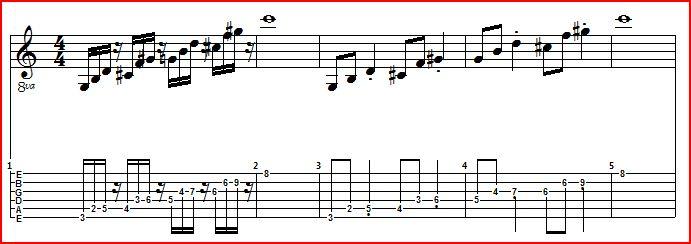Lesson 30
Home
Lesson 30 TEF's
Notes to Lesson 30
This is our last lesson on arpeggios and it's all about diminished scale runs.
There are five exercises and they pretty much speak for themselves.
Remember that diminished chords are made of minor thirds, and produce two
tri-tones (diminished fifths). That means that diminished runs will be
used as dominant substitutes besides as the connecting runs for passing chords.
My best description of diminished arpeggios is that they always seem to want to
go somewhere, that is, resolve to something.
Exercise 24 is on the 3rd, 2nd, and 1st strings.
Exercise 25 is on the 4th, 3rd, and 2nd strings.
Exercise 26 an extended exercise on the 4th, 3rd, 2nd, and 1st strings.
Exercise 27 was originally an ascending G diminished chord that
starts at the G on the 6th string and ends up at the D on the 1st string.
As you only have three diminished 7 chords before they repeat, I give two more.
I changed the name to Ascending Diminished 7. I love this exercise as it reminds
me of the organ background music in silent movies indicating a chase!
Exercise 28 was also originally the descending G diminished chord that
correlates to Exercise 27. I added the two additional scales and changed
the name to Descending Diminished 7.
Bonus Exercise, Tri-tonic Runs:
Our frequent guest contributor, Bob Armstrong, sends this bonus exercise.
Here's Bob's explanation as to how to use this run:
"Tri-tonic
substitutions maybe are more of a lick, and not at all an arpeggio. Or
perhaps this is a lick which consists of a series of short arpeggios.
The tri-tonic sub can be played over any major chord, or over any dominant 7th
(or 9th, 11th, or 13th) chord.
"The 'mechanics' are as follows: The 1, 3, and 5 notes are played.
Let's use the key of C, so the C, E, and G notes are played single- string
going up. The flat of the G comes next (which is the b5 of C), followed
by Bb, followed by Db, then the Db is flatted which makes it a C from which
you play the one, three, and five notes of the C scale again, but an octave
higher than the original one, three and five you played to start this series.
This works because the exact center of the C scale is the F#/Gb (and by this,
I mean that there are seven chromatic notes counting up from C to F# and seven
chromatic notes counting down from C an octave higher down to F#).
Here's Bob's
Tri-tonic lick applied to a V - I chord progression in C:

Bob Armstrong's Tri-tonic
Substitution Lick
"Each three note segment can be added to, that is, instead of just a triad,
you can use a Major 6, Dominant 7, Major 7, etc. Also, with a slower
tempo, I like to add both the 6 and dom. 7th notes to each segment. Or,
play the 1,3,5,6, and Maj 7 tone over the 1 chord.
"On a fast tune (e.g., 240 beats per min), I give three notes per unit and two
units per measure. My count is 'one and two, three and four' for each
measure. On a four-note-per unit job (8 notes to the measure), my count
is 'one and two and three and four and.' When you use the five-note
units (e.g., 1, 3, 5, 6, maj.7), the count is 'one and two and three, four'
(no note on 'four.')
"I don't pretend to have exhausted all the possibilities of tri-tonic subs."
Thanks,
Bob, for that great idea. I've included it as a very short TEF forced
against a Mickey Baker V - I chord progression in C with a rhythm guitar for
an idea of how it might sound. If any of you create your own tri-tonic run,
please send it and I'll add it to the Lesson.
Deja vu: Let's continue building
our Standards notebook we started at Lesson 17. In fact, if you're like
me, you never pick up a collection of tunes without mentally adding the new
chords, right? Sure you do! Putting my actions where my mouth is,
I've added a 1944 vintage tune that sure sounds great with Mickey's
substitutions, "I'll Walk Alone". This time I've done something a little
new. I've added the names of the common chords from the sheet music so
that you can try your hand at some different changes if you like. Please share with
us what you create.
As
always, just keep it FUN!
